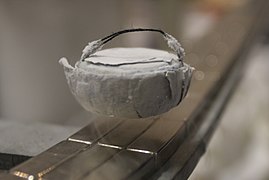
| Articles about |
| Electromagnetism |
|---|
 |
Superconductivity is a set of physical properties observed in superconductors: materials where electrical resistance vanishes and magnetic fields are expelled from the material. Unlike an ordinary metallic conductor, whose resistance decreases gradually as its temperature is lowered, even down to near absolute zero, a superconductor has a characteristic critical temperature below which the resistance drops abruptly to zero.[1][2] An electric current through a loop of superconducting wire can persist indefinitely with no power source.[3][4][5][6]
The superconductivity phenomenon was discovered in 1911 by Dutch physicist Heike Kamerlingh Onnes. Like ferromagnetism and atomic spectral lines, superconductivity is a phenomenon which can only be explained by quantum mechanics. It is characterized by the Meissner effect, the complete cancelation of the magnetic field in the interior of the superconductor during its transitions into the superconducting state. The occurrence of the Meissner effect indicates that superconductivity cannot be understood simply as the idealization of perfect conductivity in classical physics.
In 1986, it was discovered that some cuprate-perovskite ceramic materials have a critical temperature above 90 K (−183 °C).[7] Such a high transition temperature is theoretically impossible for a conventional superconductor, leading the materials to be termed high-temperature superconductors. The cheaply available coolant liquid nitrogen boils at 77 K (−196 °C) and thus the existence of superconductivity at higher temperatures than this facilitates many experiments and applications that are less practical at lower temperatures.
- ^ Combescot, Roland (2022). Superconductivity. Cambridge University Press. pp. 1–2. ISBN 9781108428415.
- ^ Fossheim, Kristian; Sudboe, Asle (2005). Superconductivity: Physics and Applications. John Wiley and Sons. p. 7. ISBN 9780470026434.
- ^ Bardeen, John; Cooper, Leon; Schrieffer, J. R. (December 1, 1957). "Theory of Superconductivity". Physical Review. 108 (5): 1175. Bibcode:1957PhRv..108.1175B. doi:10.1103/physrev.108.1175. ISBN 978-0-677-00080-0. S2CID 73661301. Retrieved June 6, 2014. Reprinted in Nikolaĭ Nikolaevich Bogoliubov (1963) The Theory of Superconductivity, Vol. 4, CRC Press, ISBN 0677000804, p. 73.
- ^ Daintith, John (2009). The Facts on File Dictionary of Physics (4th ed.). Infobase Publishing. p. 238. ISBN 978-1-4381-0949-7.
- ^ Gallop, John C. (1990). SQUIDS, the Josephson Effects and Superconducting Electronics. CRC Press. pp. 1, 20. ISBN 978-0-7503-0051-3.
- ^ Durrant, Alan (2000). Quantum Physics of Matter. CRC Press. pp. 102–103. ISBN 978-0-7503-0721-5.
- ^ Bednorz, J. G. & Müller, K. A. (1986). "Possible high Tc superconductivity in the Ba−La−Cu−O system". Z. Phys. B. 64 (1): 189–193. Bibcode:1986ZPhyB..64..189B. doi:10.1007/BF01303701. S2CID 118314311.